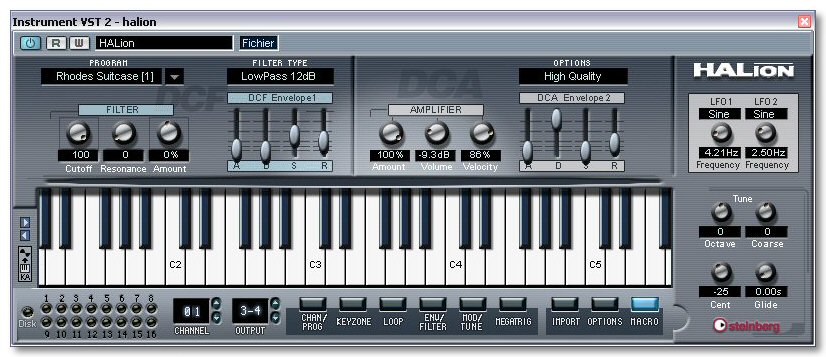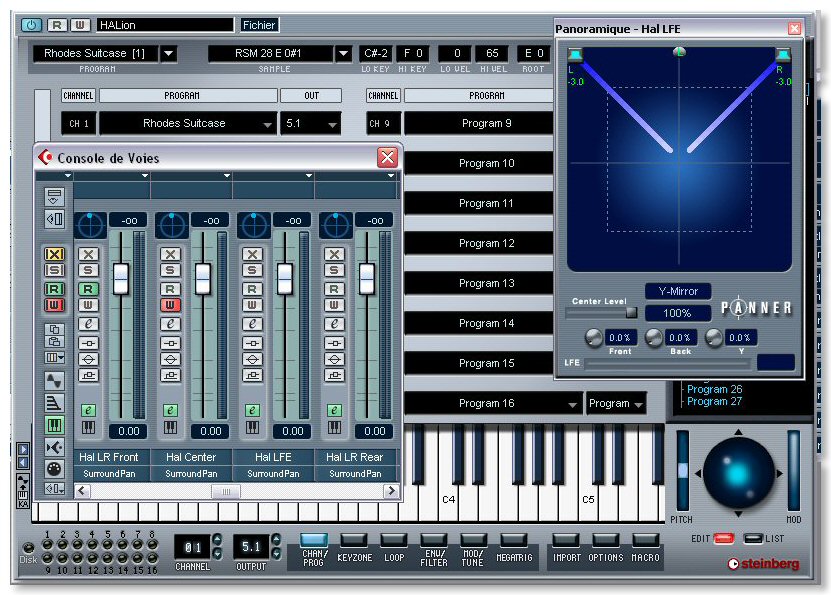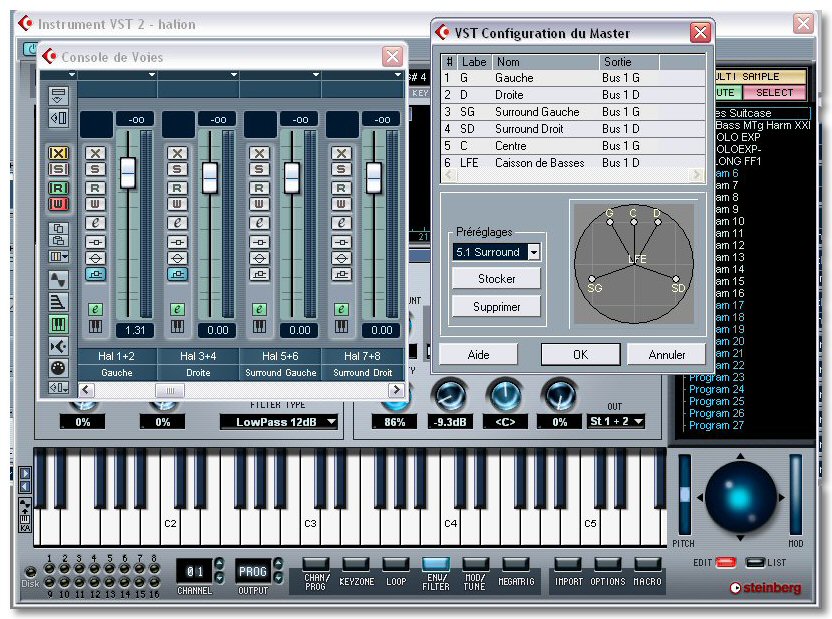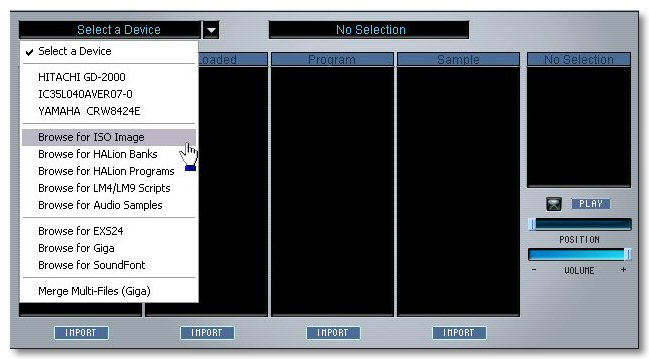HALion 2

This article was first written for Keyboards / Home Studio. It is reproduced here with their kind permission, thanks ,o)
In June 2001, Steinberg released HALion, if not the first virtual sampler, the first to have the marketting force of one of the leader on the market. Other editors followed the example, especially Native Instruments, which as often pushed the concept to its last entrenchments. The world of Computer Assisted Music then became infatuated with Kontakt, and it soon became fashion to run HALion down. HALion 2.0 should Karl Steinberg's answer to the deTraKtors of the first version...

Steinberg visibly changed their strategy. Before,
it was rather frequent that a product (especially plug-ins) was released, and,
even if it was succesful, no major update followed. For some times, we can see
that versions 2.0 are regularly released by Steinberg.
The installation does not set problems. As for
Groove Agent, Steinberg modified their install program, multi-user XP configurations
do not bother it anymore.
The program is bundled with 4 sample CDs, the same as for version 1, but added surround banks are present on the install CD. Concerning the manual, it is very complete, but in English for the moment.
The aim of this article is not to go into details about HALion 2. Indeed, the first version has been largely presented in Keyboards #158 (also see our test). I prefer you to discover the improvments brought by this update. Simply know we can still find the followin interfaces:
- « Macro » page with general settings
- « Channel/Program » page, where we can manage the 128 instruments of the bank
- « Keyzone » page for the management of the samples of an instrument
- « Waveloop » page for the samples looping
- « Envelope » page, which name is explicit enough
- « Mode/Tune » page, where we can mange all about modulations, tuning and grouping
- « Options » page with the system parameters. The import functions which were placed there in the first version have now a dedicated interface.
- « MegaTrig » page, which allows to trig one or several samples if one to four conditions are satisfied
Those who used the first version won't be confused by the subtle modifications that appeared. So it is a soft transition, and version 2 perfectly subsitutes for the previous version in projects made with version 1. The GUI has been discretely modified. In my (subjective) opinion, I think it is far more smart and lisible than before. Stability is exemplary, I could not notice a single malfunction, crash or bug; even if the CPU consumption remains important. My PIII 1GHz / 384 MB RAM was unable to read the demo song in its "XL" version.
However, HALion ergonomy remains perfect, it is simple to use, but, once again, it is maybe subjective.
Surround

One of the main innovations is the management of
Surround 5.1. The modest home-studio will not bindingly $have the use of it,
but a musician who works for DVDs conception will find an ideal tool for his
sound illustrations.
So the pop-up menu which allows to choose between
the instruments audio outputs has a 5.1 options added. It can be used as an
extra stereo output too, which can be useful.
Then it depends on the sequencer which is used.
HALion is based on the VST 2.3 protocol. Todays (June 5th 2003), only Nuendo
2.0 can use it, Cubase SX 2.0 should follow. In this configuration, HALion adds
a 5.1 track in the mixer, which can be conected to a 5.1 master.
If the host sequencer is not in VST 2.3, HALion adds 4 tracks in the mixer, 2 stereo Front / Rear, a central track and a subwoofer track. Concerning the Bus output, each track will have to be manually assign to one of the six channels, or directed to the Bus Surround Pan of Cubase or Nuendo.
Once understood, the exploitation is rather simple, even if the manual curiously gives few informations on the subject.

I imagined it would be possible to spacialize each sample of an instrument to the wanted 5.1 channel. I asked Yvan Grabit, and it is impossible. To pan each sample through a Surround Pan would set some problems concerning performances. Nevertheless in a next update, it will be possible to assign a sample directly to the rear stereo output for example, or to pan a sample between left/right and rear/front.
But this limitation which is not a real one can
be get round. Opening of the Tips & Tricks rubric: in the CHAN/PROG,
select the Program audio output. For each sample, ENV/FILTER page,
select the audio output you want among the 8 stereo/mono outputs. Activate the
5.1 in the Master. In the mixer, you just have to direct the 8 voices
of HALion to the Master 5.1 output you want, Left, Right, Rear Left,
Rear Right, Center or Sub. Here we are, we just built a surround instrument
with mono and stereo samples! End of the Tips & Tricks rubric...
As you can see, the 5.1 management is really a major innovation which opens rather fantastic perspectives, even if its use remains for the moment reserved to specific domains, such as cinema and DVD. This will have to be kept in mind!
Wiht or without filters ?
Well; HALion 1 filters... They will have inspired many messages on forums! Rapidly, nearly everybody repeated this cliché: "Filters in HALion are no good!". So I asked some musicians why they did not like it. They answered this was very subjective and that, as far as they were concerned, these filters were, I quote, "not musical". So...
Steinberg's answer on the subject is clear: complete re-building of the filters and the enveloppes.
Let's start with the famous filters. Steinberg should have thought they were not so bad, because they are present in this new version. But they add a series of filters made by Waldorf! Using it, it is difficult to have an objective opinion. Waldorf's ones are more... let's say violent, but clearly more precise. Then, all will depend on the use of the filters, and to what you apply them.
Another point on which Steinberg radically changed: the enveloppes. It won't be easy to make short!

We have the two classical ADSR enveloppe for the amplitude and the filter. Where it becomes a little more complex, it is that 4 points is a minimum. We can go up to 32! The 28 points are added to the 4 ADSR points. What can be obtained doing this is rather delirious.
Furthermore, there is alot of rather convenient functions as the prest system which enables to save and load settings. Please note the possibility to synchronize the passage time from a point to another with the beat of the song. In short, thes enveloppes are formidable and very convenient to use.
But htat's not all! There is a Step enveloppe. It interacts with the Modulation page in which we can choose a modulation source. We will choose here Step Env as a modulation source and Pitch as a modulation dest for example. Back to the ENV/FILTER page, and select the Step Enveloppe. Then you will simply have to draw the variations with the mouse (32 steps max). In this example, we just created a little arpegiator. But we could have modified resonnance, Cut Off, Pan or Volume. Here again, we have a system of presets.

All well considered, we are nearer the synthesis domain than the sampling. The ones who hate using "natural samples" will find there something to... well... transform their samples in order to create new sounds.
Some news
We talked about the most important, but new functions have been discretely added here and there on the interfaces.

-
Concerning the import, the S770 Roland format is now supported and HALion knows how to work from ISO files.
-
Archive Function: enables to save banks or instruments with their samples. Ideal to transfer a project to another computer with all the necessary files.
-
Release Trigger : enables the release of a sample by Note Off depending on certain conditions.
-
Attack and Release Enveloppe added as Modulation target.
-
Possibility to copy samples from the Pool or the Nuendo/Cubase Project Window in HALion with a simple drag 'n' drop.
- I surely forgot some of them!
A word about the CDs
HALion is bundled with 4 CDs full of all-genre sounds. Quality goes from middle (accoustic piano) to really good (drum kits and bass). Everyoe should find what he wants, even if some of the drum loops will be rather difficult to place in a song, as they are very original!!
The 5.1 banks are there for the demo, and are of very good quality. We can find drum kits, latin percussions, a rather abstruse pad sound, an extract from WIzzo's "Urban Atmosphere" and a collection of samples dedicated to the cinema, with a lot of various noises, in order to impress your neigbours (dixit the manual)!
Conclusion
Let's consider two different cases:
-
You wish to get HALion. Then get version 2 directly. Who can most can least...
- You already have the first version. Si you use this plug-in as a simple sample player without using filters and if you ar not interested in 5.1, the update, even if cheap, will be of no interest for you. On the contrary, if you are interested in extreme modifying of the sound, going to version 2 is essential
There remains the price. Nearly 400€, some will find it expensive. One has to relativize and to compare it with the price of the equivalent hardware ,o)
See ya, here or elsewhere...
PS: thanks to Yvan Grabit who was kind enough to have a look to my modest contribution and to bring the necessary precisions...
-
Pros : Simplicity of use, compatibility with many formats, 5.1, power of the enveloppe
-
Cons: CPU consumption rather important
- Sounds : 16/20
- Ergonomics: 19/20
- Quality / Price rate: 17/20
- Editor : Steinberg
- Distributor : Steinberg-France
- Minimum configuration :
- PC: Pentium III or Athlon 500 MHz, 1 GHZ recommanded, 256 MB RAM, 512 recommanded, Windows 2000/XP, 1 rapid hard drive for streaming, Cubase SX/XL, Cubase VST 5.x, Nuendo 1.5 or more, or any other VST 2.0 or DXi2 compatible application
- MAC : G4 450 MHz, 733 MHz recommanded, 256 MB RAM, 512 recommanded, Mac OS 10.2 or more, 1 rapid hard drive for streaming, Cubase SX/XL, Nuendo 2.0, or any other VST 2.0 or DXi2 compatible application, a Mac OS 9 version should be available soon in public beta
- Price Steinberg.net : 399 €uros (with 16% taxes). Consult your local distributor. Update price in France: 37€.





